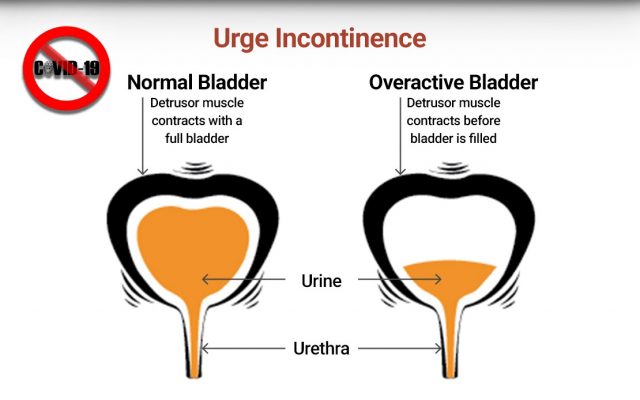FREQUENT URINATION TREATABLE, NOT A LIFE SENTENCE

Source: Bernama
KUALA LUMPUR, 12 August – With many people homebound and working from home due to the movement control, there has been a rise in complaints pertaining to frequent urination, according to a urologist.
In most cases, the patients suspect they have an overactive bladder (OAB) and request treatment for this condition.
However, before any medication or treatment is prescribed, the doctor would want to ascertain the cause of their frequent visits to the toilet as it could also be due to a urinary tract infection or simply consuming more fluids now that people are staying at home mostly.
Said consultant urologist at Gleneagles Kuala Lumpur, Dr. Warren Lo Hwa Loon: “To determine whether you have OAB, the first thing to rule out is overdrinking or consuming too much fluids. Nowadays, many people who work from home tend to drink more than usual and that inadvertently results in frequent toilet visits.
“Usually, the normal fluid intake per day is about two to 2.5 litres which roughly equals seven to eight glasses of water. Some people tend to subconsciously overdrink whenever they are not occupied, creating unnecessary urinary frequency and urgency which is similar to having an OAB.”
HIGHER INCIDENCE OF OAB AMONG WOMEN
According to Dr Lo, OAB is a symptom complex of urinary urgency, usually accompanied by urinary frequency and nocturia (night urination), with or without urinary incontinence and in the absence of urinary tract infection or other obvious pathology.
He said in Malaysia, OAB is observed more often in women (39.5 percent) than men (26.8 percent), with the condition usually associated with incontinence or loss of bladder control.
“Among women, 9.3 percent reported having OAB with incontinence. Among men, only 2.6 percent reported having it with incontinence,” he said.
While OAB is not necessarily a part of aging, there is evidence indicating that it becomes more common as people age, he said, adding that about 20 percent of people aged 70 and above report symptoms while 30 percent of those aged 75 and above do so as well.
“In general, it is not an uncommon condition among the population,” he said.
RULE OUT OTHER UNDERLYING FACTORS
Dr Lo said to ascertain whether one is having OAB, it is necessary to strike out other possible underlying contributing factors before going into various treatment regimes and options for OAB.
He said besides overdrinking fluids, OAB can be caused by neurological disorders such as Parkinsonism or stroke, spinal cord injuries or even post-spinal surgeries.
Bladder outflow obstruction due to prostate enlargement, bladder stones or urethral narrowing can also lead to symptoms of OAB.
“It is also important to rule out bladder cancer as this disease can often present with urinary urgency, frequency and blood in the urine, mimicking urinary tract infections or OAB.
“A common perception is that urinary tract infection, or UTI, will give us a sensation of urgency, associated with OAB-like frequent urination, but with a burning sensation and occasionally foul-smelling and cloudy urine. Sometimes UTI patients who do not experience some of the other symptoms think that they are suffering
from OAB instead. Treatment with antibiotics will solve the urinary tract infection,” he added.
WHAT ARE THE TREATMENT OPTIONS?
Dr Lo also said many people tend to cope silently with OAB or think that urinary incontinence is an inevitable part of aging. Fortunately, most overactive bladders can be treated with lifestyle modifications.
“Caffeinated and carbonated products and citrus and alcoholic beverages are known to be bladder stimulants and are largely lifestyle choices. Avoiding these drinks and avoiding overdrinking (including plain water) will definitely reduce the OAB-like symptoms. For milder OAB symptoms, Kegel exercises can also help by relaxing
the pelvic floor muscle,” he explained.
He said patients with severe symptoms may be given medications which, in many ways, help to relax the bladder, thus allowing for more urine storage and reducing urinary urgency and frequency or even incontinence. Medications are useful especially for those with neurological conditions.
“It is life-changing for many who have been long troubled by their condition. Many people tend to endure the inconvenience and would shy away from social activities due to the possibility of accidentally wetting their pants or smelling of urine due to urinary incontinence,” said Dr. Lo.
However, in some patients, the medications may lead to side effects such as dry mouth and constipation. Also, patients with cognitive impairment, glaucoma or thyroid issues who are prescribed medications for OAB need to be supervised and monitored by their healthcare personnel on a regular basis.
According to Dr. Lo, Botox (an injectable drug usually used to relax muscles that cause wrinkles) can also be injected into the bladder to help its muscles to relax, adding that it can be a viable treatment option if medications do not work or they are not suitable for the patient.
“Botox usually lasts for six months. Injecting Botox into the bladder is a day-care procedure and seasoned patients can have it performed under local anesthesia. There is a small risk of urinary retention and urinary tract infection post-surgery,” he added.
Implanting a sacral neuromodulation (bladder pacemaker) is the last resort if all the above treatment options do not provide relief. The device is designed to modulate the nerves that control the contractility of the bladder. It works for two polarising conditions: severe overactive bladder and underactive bladder.
Dr. Lo said the patient can control the intensity of the device to suit the severity of their OAB symptoms. The device has to be changed every five to seven years, depending on the voltage used.
“It is an invaluable device for those with intractable overactive bladder with severe urine leak problems. It also remains the only device to stimulate bladder contractility, and used by patients with bladder failure who would otherwise rely on urinary catheters to drain their urine. It allows them to pass urine naturally on their
own without the need of a catheter,” he added.
— BERNAMA



2 comments
Windy Talsma
05/07/2022 at 1:50 PM
Good post. I learn something new and challenging on websites I stumbleupon on a daily basis. It will always be useful to read through content from other authors and use something from their sites.
Admin SC
28/10/2022 at 10:31 AM
Thank you for your Interest at our website, glad that it’s useful for community.. thank you also for the some advice that we could use someday 🤗🤗🤗